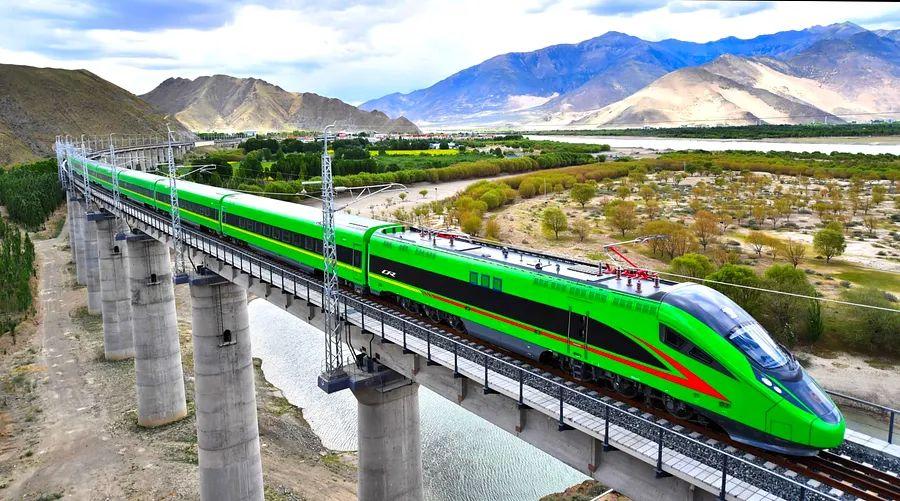Faster, cleaner, and greener: The future of the world’s rail systems

With advanced technology, eco-friendly solutions, and increased efficiency, rail is the only mode of transport strategically positioned to become the backbone of our future mobility infrastructure.
While some high-speed projects are on the horizon, the focus remains on ensuring the growing urban population remains mobile, all while minimizing the environmental impact of transportation.
And let’s not forget the pandemic.
Similar to other sectors within the travel industry, train operators worldwide have endured one of their most challenging periods in recent history over the past two years.
In 2020, passenger numbers plummeted as lockdowns kept commuters and leisure travelers confined to their homes.
Two years later, traditional weekday commuting seems to be a thing of the past, with many opting to work remotely or visit the office only a few days a week.
This shift poses a significant challenge for global rail companies, which have long depended on this reliable and profitable source of income since the mid-1800s.
Given these circumstances, it might seem an odd moment to discuss a 'golden era' for rail travel.
However, as we approach the 200th anniversary of the first passenger railway in 2025, it is more crucial than ever for trains to offer sustainable mobility solutions amidst the growing pressures of climate change, urbanization, and population growth.
A 2019 report by engineering consultancy Arup predicts that the global population will reach approximately 9.5 billion by 2050, with 75% of people living in urban areas.
Arup estimates that the global urban population is expanding at a rate of two people every second, adding 172,800 new city residents daily. While some regions, such as parts of Europe and Japan, face population decline, 90% of global population growth is expected to occur in the cities and megacities of the developing world.
To support these rapidly growing cities, regions, and megacities, efficient public transportation is not just a luxury – it’s a necessity.
Cars, whether electric or not, cannot handle such a massive increase in population. Rail systems – including trains, trams, and metros – will be crucial in preventing congestion that could paralyze cities and national economies.
Bullet trains: How much faster can they really go?

High-speed rail plays a pivotal role in the future of transportation.
Sleek, modern 'bullet trains' are making headlines as the network of high-speed railways across Europe and Asia continues to expand, with new lines under development in countries like France, Germany, Spain, India, Japan, and notably in China, where the high-speed network is set to reach 50,000 kilometers by 2025.
When England’s High Speed 2 (HS2) line is completed in the early 2030s – despite controversies over budget overruns and the route passing through sensitive landscapes – it will feature the world’s fastest conventional trains, capable of reaching 250 mph (400 km/h), with regular service operating at 225 mph.

However, after decades of operation, countries like France, Japan, and China have found that the advantages of operating high-speed trains exceeding 200 mph are outweighed by the significantly higher maintenance and energy costs involved.
Now, the high-speed leaders in Japan and China are shifting away from 'steel-on-steel' technology and exploring trains that could reach speeds of up to 373 mph (600 km/h).
The idea of ultra-fast trains propelled by magnetic levitation (maglev) has been heralded as 'the future of travel' for over 50 years, but apart from a few experimental lines and a route connecting Shanghai’s city center to its airport, it has remained mostly theoretical.
Construction began in 2014, and the project was initially expected to be completed by 2027, with the Nagoya-Osaka section following a decade later. However, delays in securing approval for a segment of the line have left the opening date uncertain.
The project has faced significant delays and soaring costs, leading many to question its economic viability – concerns that have not gone unnoticed internationally.
China, however, is unlikely to face such challenges, as it continues to develop maglev lines as an alternative to short-haul flights and to offer high-speed travel across its densely populated urban regions.
China's strategy is to create 'three-hour transportation circles' around its major cities, fostering economic hubs by connecting multiple cities into powerful economic clusters.
In the southern part of the world's most populous nation, the Pearl River Delta – which includes Hong Kong, Guangzhou, and Shenzhen – is already home to over 120 million people.
Chinese urban planners aim to merge nine cities in the region, creating an urban area covering 26,000 square kilometers – 26 times the size of Greater London.
Maglev routes are planned for the Shanghai-Hangzhou and Chengdu-Chongqing corridors, with many more possible if these initial lines prove successful.
However, those hoping to see maglev technology spread beyond Japan and China are likely to be disappointed. The immense cost and the difficulty of integrating maglev systems with existing rail networks may hinder its expansion worldwide.
While metros, trams, and other urban rail systems may not have the glamorous appeal of high-speed trains, there’s no denying their critical role in boosting national economies and enhancing urban life.
Facing severe congestion and pollution in its crowded cities, China launched 29 new metro lines in December 2021 alone, adding a total of 582 kilometers to its network.
Other countries with rapidly growing cities will need to adopt similar strategies soon to avoid being overwhelmed by urbanization.
To meet this challenge, the rail industry, with the backing of politicians, will need to act swiftly on multiple fronts to increase capacity, improve efficiency, ensure reliability, and enhance accessibility.
Driverless trains: Will they soon be a reality on tracks near you?
In line with this, many nations are making substantial investments in autonomous trains, and it's expected that these will become a common sight in the 2020s.
Automated operations have been in place for decades – for example, London Underground’s Victoria Line has been partially automated since its opening in 1967 – though typically limited to isolated lines with uniform trains running on fixed schedules.
China has taken the lead in autonomous rail technology in recent years, debuting the world's first high-speed driverless trains, capable of reaching speeds of 186mph (300kph) on the route between Beijing and the 2022 Winter Olympics venues.
Japan is also exploring self-driving ‘bullet trains’ that can autonomously travel from stations to depots for maintenance, allowing human operators to focus on running more commercially viable trains.
Operating driverless trains on dedicated tracks is one challenge, but ensuring their safe operation on traditional, mixed-use networks – where passenger and freight trains, each with distinct characteristics, speeds, and weights, share the same infrastructure – is a far more complex task.
Big Data and the Internet of Things will enable different modes of transport to communicate with each other and their surrounding environments, creating opportunities for more seamless, multi-modal travel experiences. Meanwhile, intelligent robots will increasingly handle infrastructure inspections, such as tunnels and bridges, as well as support the efficient upkeep of aging systems.
Replacing diesel engines and reducing environmental footprints.
While rail is significantly greener than air travel, it still has a long way to go in cutting its carbon footprint and pollution from diesel engines. In line with UN climate targets, many nations are aiming to phase out diesel trains by 2050 or even sooner.
Across Europe and parts of Asia, the majority of high-traffic routes have already transitioned to electric, although progress is uneven. For example, Switzerland has nearly 100% electric rail, while the UK is below 50%, and some developing nations have yet to make significant strides.
In North America, diesel remains dominant, especially on major freight lines, with little momentum for the kind of electrification that has been seen in Europe and Asia.
Battery technology is poised to play a key role in replacing diesel, both for heavy freight and quieter passenger lines where full electrification isn't feasible. Numerous battery-powered prototypes are currently being tested, and as the technology advances, rail's reliance on diesel is expected to significantly decrease by the end of this decade.

For many, hydrogen is seen as the key to decarbonizing rail transport. Green hydrogen, produced in dedicated plants powered by renewable energy, can be used to fuel cells that run electric motors.
Alstom, the French train manufacturer, is at the forefront with its Coradia iLint hydrogen-electric train, which first carried passengers in 2018. This has paved the way for production models now being built for several European nations.
Global rail networks are also facing challenges from natural forces.
Many rail lines in low-lying coastal regions are vulnerable to rising sea levels and extreme weather events, which pose a serious threat to existing infrastructure.
Away from coastal areas, stronger winds, more intense rainfall, and temperature extremes are triggering flash floods, landslides, and equipment malfunctions, all of which disrupt travel and result in millions of dollars in repairs each year.
Newly built or revamped railways are increasingly being designed with climate change in mind, incorporating improved drainage systems, environmental safeguards, and efforts to restore natural landscapes to enhance safety and reliability.
Meanwhile, the growing recognition of the environmental impact of air travel has sparked a revival of overnight rail journeys in Europe.
This movement continues to gain traction, with new routes planned for 2022/23 and private operators preparing to enter the market.
Looking toward the future, the coming decades hold great promise for the evolution of rail travel.
In addition to investing billions in new trains, tracks, and technology to enhance services, there's an increasing sense within the industry that fresh approaches are necessary to avoid repeating the mistakes of the past.
Currently, despite the dedicated efforts of some operators, the overall passenger experience remains inconsistent.
Digital technology will play an ever-expanding role, from booking tickets to selecting seats and planning a seamless journey from start to finish.
"There's no doubt that travel with a positive climate impact is the future, and I’m excited about the part that travel tech companies will play in this transformation," says Naren Shaam, CEO and founder of Berlin-based travel platform Omio.
"With consumers traveling more than ever – we’ve seen a 150% increase in bookings since January 2022 – it’s crucial that we empower them with digital tools that allow for seamless cross-border rail travel over long distances," Shaam adds.
The pandemic has actually sped up this shift, and we've witnessed a long-term move from booking train tickets at kiosks to booking via mobile apps.
In the next five years, platforms like Omio and Rome2Rio will enable travelers to input their start and end points, and the platforms will automatically find the quickest, most affordable, and eco-friendly routes by combining various modes of transport and providers. A single click will allow users to purchase one ticket for the entire journey.
Shaam adds: "In 30 years, we won’t even recognize what travel will be like; there will be no need for apps or tickets, as digital systems will automatically understand and charge you for your journey – a truly seamless experience!"
While predictions should always be taken with a grain of salt, we can be sure that the desire to travel will persist, despite global disruptions and the urgent need to tackle climate change.
By 2050, rail systems for both passengers and freight will be the core of our transportation networks, with inter-city routes connecting multimodal hubs to local transport networks.
With the right political and technical backing, rail will become an even more significant part of international travel, offering a premium alternative to road and short-haul flights.
In the foreseeable future, global investments will largely focus on traditional steel-on-steel rail systems. There's no reason to believe that this will not continue to shape the future of rail travel for the coming decades, just as it has for nearly two centuries.
Ben Jones is a freelance railway and travel writer, senior correspondent at The Railway Magazine, and a regular contributor to various railway publications in the UK. Follow him on Twitter @flywheelmedia1.

1

2

3

4

5
Evaluation :
5/5